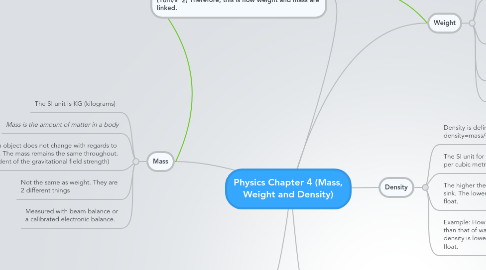Physics Chapter 4 (Mass, Weight and Density)
by BANDA BHARGAVI .

1. Mass
1.1. The SI unit is KG (kilograms)
1.2. Mass is the amount of matter in a body
1.3. Mass of an object does not change with regards to it location. The mass remains the same throughout. ( Independent of the gravitational field strength)
1.4. Not the same as weight. They are 2 different things
1.5. Measured with beam balance or a calibrated electronic balance.
2. Gravitational field
2.1. Gravitational field is a region in which a mass experiences a force due to gravitational attraction
2.2. Gravitational field STRENGTH (g) is defined as the gravitational force acting per unit mass
2.3. Tides are an example of the moons gravitational force on earth
3. Force= mass x acceleration. The force is the weight of the object while acceleration of constant freefall is (10m/s^2) Therefore, this is how weight and mass are linked.
4. Weight
4.1. The weight of an object is the gravitational force or gravity acting on it
4.2. SI unit is Newton (N)
4.3. It is a vector quantity with both magnitude and direction. The direction is the gravitational pull acting on it which is downwards (towards centre of earth)
4.4. The weight of an object varies if the gravitational pull is different at the places. (eg. moon and earth)
4.5. Measured using a spring balance
5. Inertia
5.1. The inertia of an object refers to the reluctance of the object to change its state of rest or motion, due to its mass
5.2. Mass is a measure of inertia. the GREATER the mass, the GREATER the inertia.
5.3. Example: inertia explains why we must put on our seatbelts while driving. IF the driver suddenly applies the breaks, the seatbelt will provide opposing force to overcome inertia thus causing the driver not to be flung forward.
5.4. The mass of an object affects inertia and not the weight
6. Density
6.1. Density is defined by the formula, density=mass/volume
6.2. The SI unit for density is kilogram per cubic metre (Kgm^3)
6.3. The higher the density, the object will sink. The lower the density the object will float.
6.4. Example: How can a heavy ship float on water if its density is higher than that of water? The ship contains large volumes of air whose density is lower than that of water and thus it causes the ship to float.


